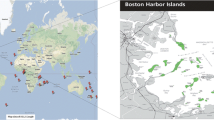Abstract
Within the last 20 years, the US has mounted amassive campaign against invasions bynon-indigenous species (NIS) such as zebramussels, kudzu, water hyacinths, and brown treesnakes. NIS have disrupted native ecosystemsand caused hundreds of billions of dollars ofannual damage. Many in the scientificcommunity say the problem of NIS is primarilypolitical and economic: getting governments toregulate powerful vested interests thatintroduce species through such vehicles asships' ballast water. This paper argues that,although politics and economics play a role,the problem is primarily one of scientificmethod. Even if commercial interests werewilling to spend the necessary funds to controlNIS, and even if government were willing toregulate them, ecological theory is notadequate to provide clear direction for eithereffort. The paper argues there is nocomprehensive, predictive “theory ofinvasibility,” as part of a larger theory ofcommunity structure, that might guideecological decision making regarding NIS, andfor at least three reasons. (1) There is nofirm definition of “NIS,” “native,” “exotic,”and so on, and ecologists do not use the termsconsistently; as a result, biologists debatingvarious accounts of community structure andecological explanation often do not even makelogical contact with each other. (2) Thedominant theory used to understandinvasibility, island biogeography, has noprecise predictive power and is unable toclarify when NIS might promote biodiversity andwhen they might hinder it. (3) There are nofirm, empirical generalizations that revealwhen a colonizer or a NIS might be likely totake over a new environment, and when it mightnot succeed in doing so. As a result,scientists have only rough “rules of thumb” toshore up their arguments against NIS. Given theincompleteness of current ecological theory,the paper closes with several suggestions forways that study of NIS might enhanceunderstanding of basic commmunity structuresand vice versa.
Similar content being viewed by others
References
Bazzaz, F.A.: 1986, ‘Life History of Colonizing Plants', in H.A. Mooney andJ.A. Drake (eds), Ecology of Biological Invasions, Springer-Verlag, New York, pp. 96-110.
Bright, C: 1995, ‘Bio-Invasions: The Spread of Exotic Species', World Watch 8(4), 10-20.
Castri, F. Di: 1991, ‘The Biogeography of Mediterranean Animal Invasions', in R.H. Groves andF. Di Castri (eds), Biogeography of Mediterranean Invasions, Cambridge University Press, New York, pp. 439-452.
Crawley, M.J.,Harvey, P.H. andPurvis, A.: 1996, ‘Comparative Ecology of the Native and Alien Floras of the British Isles', Philosophical Transactions of the Royal Society of London B351, 1251-1259.
Daehler, C.: 1998, ‘The Taxonomic Distribution of Invasive Angiosperm Plants', Biological Conservation 84, 167-180.
Davis, M. andThompson, K.: 2000, ‘Eight Ways to Be A Colonizer', Bulletin of the Ecological Society of America (July), 226-230.
Fox, M.D.: 1990, ‘Mediterranean Weeds', in F. Di Castri,A.J. Hansen andM. Debussche (eds), Biological Invasions in Europe and the Mediterranean Basin, Kluwer Academic Publishers, Dordrecht, pp. 179-200.
Green, R.E.: 1997, ‘The Influence of Numbers Released on the Outcome of Attempts to Introduce Exotic Bird Species to New Zealand', Journal of Animal Ecology 66, 25-35.
Hussey, B.M.J.,Anderson, D. andLoney, S.: 1992, ‘A Checklist of Plants Found Growing in a Native or Naturalized State on Culeenup Island', West Australian Naturalist 19, 35-43.
Kaiser, J.: 1997, ‘Call for Exotic Species Task Force', Science 275(5302), 915.
Kendle, A.D. andRose, J.E.: 2000, ‘The Aliens Have Landed', Landscape and Urban Planning 47, 19-31.
Lodge, D.: 1993a, ‘Biological Invasions: Lessons for Ecology', Trends in Ecology and Evolution 8, 133-137.
Lodge, D.: 1993b, ‘Species Invasions and Deletions’, in P.M. Kareiva,J.G. Kingsolver andR.B. Huey (eds), Biotic Interactions and Global Change, Sinauer, Sunderland MA, pp. 367-387.
Lodge, D.,Stein, R.,Brown, K.,Covich, A.,Bronmark, C.,Garvey, J. andKlosiewski, S.: 1998, ‘Predicting Impact of Freshwater Exotic Species on Native Biodiversity', Australian Journal of Ecology 23, 53-67.
Lonsdale, W.M.: 1994, ‘Inviting Trouble', Australian Journal of Ecology 19, 345-354.
MacArthur, R. andWilson, E.O.: 1967, The Theory of Island Biogeography, Princeton University Press, Princeton.
McDonald, K.: 1999, ‘Biological Invaders Threaten US Ecology', The Chronicle of Higher Education (February 12), A15-16.
McKnight, B. (ed.): 1993, Biological Pollution: The Control and Impact of Invasive Exotic Species, Indiana Academy of Science, Indianapolis.
Perry, W.,Lodge, D. andLamberti, G.: 1997, ‘Impact of Crayfish Predation on Exotic Zebra Mussels and Native Invertebrates in a Lake-Outlet Stream', Canadian Journal of Fisheries and Aquatic Sciences 54, 120-125.
Peters, W.H.: 1991, A Critique for Ecology, Cambridge University Press, Cambridge.
Renaud, C.: 1996, ‘Silent Invasion’, Environment 38(8), 24.
Sala, O.,Chapin, F.S.,Armesto, J.,Berlow, E.,Bloomfield, J.,Dirzo, R.,Huber-Sanwald, E.,Huenneke, L.,Jackson, R.,Kinzig, A.,Leemans, R.,Lodge, D.,Mooney, H.,Oesterheld, M.,Poff, N.L.,Sykes, M.,Walker, B.,Walker, M. andWall, D.: 2000, ‘Global Biodiversity Scenarios for the Year 2100', Science 287, 1770-1774.
Shrader-Frechette, K. andMcCoy, E.D.: 1993, Method in Ecology: Strategies for Conservation, Cambridge University Press, Cambridge.
Shrader-Frechette, K. andMcCoy, E.D.: 1994, ‘Applied Ecology and the Logic of Case Studies', Philosophy of Science 61(1), 228-249.
Simberloff, D.: 1976, ‘Species Turnover and Equilibrium Island Biogeography’, Science 194, 572-578.
Simberloff, D. andStrong, D.R.: 2000, ‘Exotic Species Seriously Threaten Our Environment', The Chronicle of Higher Education (September 8), B20.
Simberloff, D. andWilson, E.O.: 1969, ‘Experimental Zoogeography of Islands', Ecology 50, 278-296.
Usher, M.B.: 1989, ‘Ecological Effects of Controlling Invasive Terrestrial Vertebrates', in J.A. Drakwe,H.A. Mooney,F. Di Castri,R.H. Groves,F.J. Kruger,M. Rejmanek andM. Williamson (eds), Biological Invasions, John Wiley, Chichester, UK, pp. 463-489.
Wagner, W.H.: 1993, ‘Problems with Biotic Invasives', in McKnight (ed.), Biological Pollution, Indiana Academy of Science, Indianapolis, pp. 1-8.
Webb, D.A.: 1985, ‘What Are the Criteria for Presuming Native Status?’ Watsonia 15, 231-236.
Williamson, M.: 1996, Biological Invasions, Chapman and Hall, London.
Williamson, M. andFitter, A.: 1996, ‘The Varying Success of Invaders', Ecology 7, 1661-1666.
Zera, F.: 2000, ‘New Regulations Considered to Address Ballast Water Problems’, Professional Mariner 50, 14-19.
Author information
Authors and Affiliations
Rights and permissions
About this article
Cite this article
Shrader-Frechette, K. Non-Indigenous Species and Ecological Explanation. Biology & Philosophy 16, 507–519 (2001). https://doi.org/10.1023/A:1011953713083
Issue Date:
DOI: https://doi.org/10.1023/A:1011953713083




